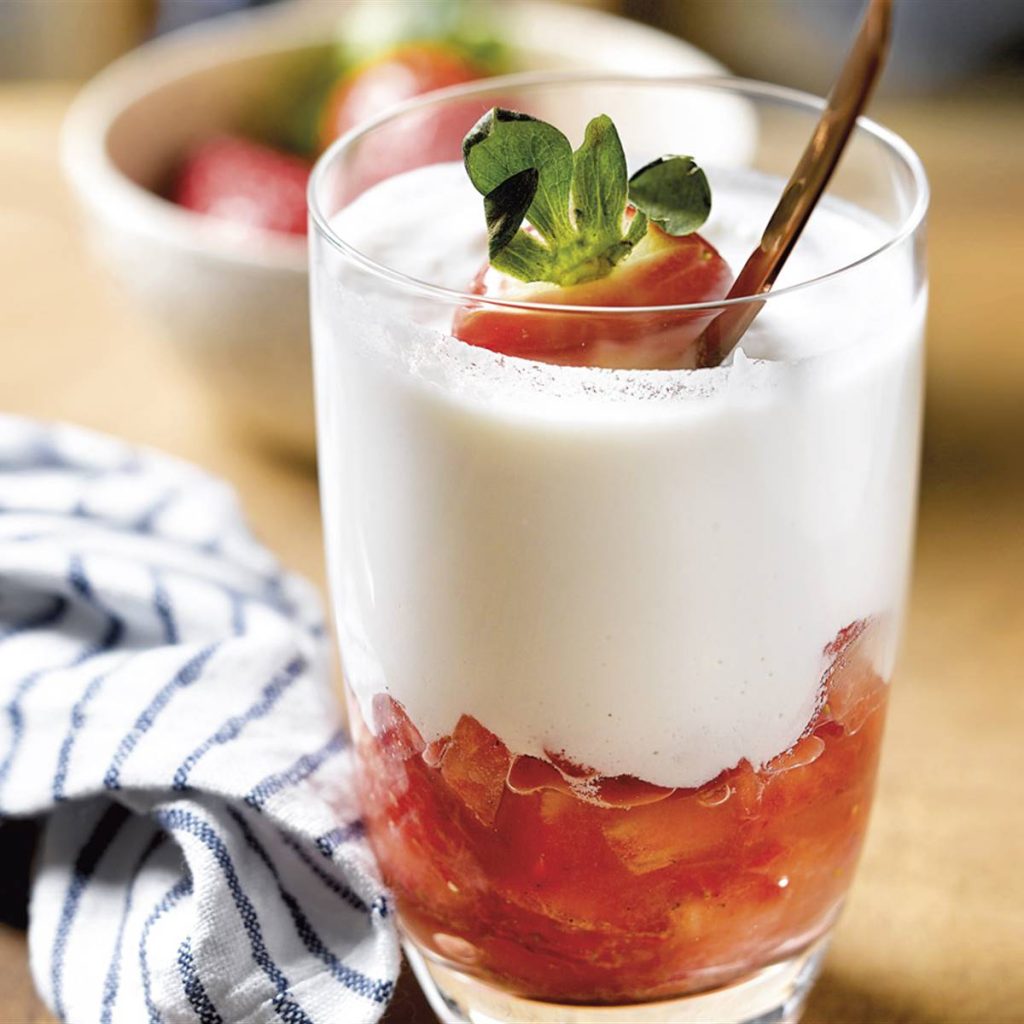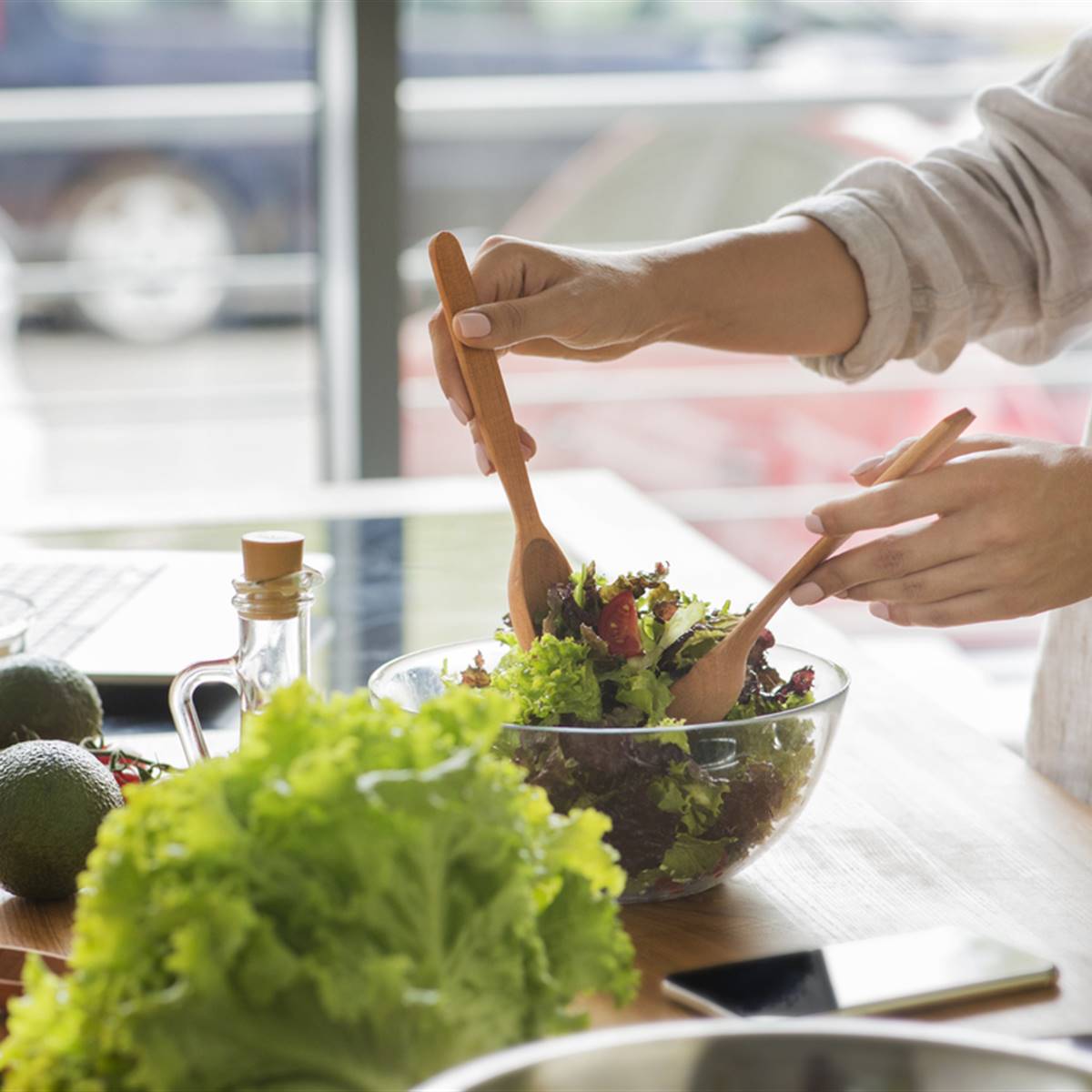These vegan yogurts are delicious, healthier, extraordinarily nutritious, and very easy to prepare. Soak it, blend, let it sit and you’re done!

HAZELNUT AND VANILLA YOGURT
Ingredients for 4
For the yogurt
- Half a cup raw hazelnuts, activated 8 hours and washed
- Half a cup cashews, activated 8 hours and washed
- 1 <>/<> cups rejuvelac
- 1/4 teaspoon vanilla
- Pinch of salt
For the caramel
- 2 ripe bananas
- 4 medjool dates, pitted
- A pinch of salt
To accompany
- 1 apple
- 1 banana
- A little cinnamon
Preparation: 15 minutes + 24 hours of rest
To activate the nuts, let them soak for 8 hours, strain the water and wash them. This will make them more digestible and help ferment.
- Place the yogurt ingredients in a blender and blend until you get a smooth cream.
- Place the mixture in a glass bowl and let it rest for about 24 hours in a dry, warm place out of direct sunlight, or in a fermenter. Cover it with a clean cotton cloth.
- After that time, divide the yogurt into four small glass jars with lids and store in the fridge until you are ready to consume it.
- Prepare the caramel on the spot by blending the ingredients in the blender until you get a very smooth cream.
- Serve with the caramel, cinnamon and apple and banana pieces. hazelnut and vanilla yogurt
With raspberries: Mash them with a few drops of stevia or coconut sugar for a low-glycemic candy.
COCONUT YOGURT WITH POMEGRANATE
Ingredients for 4
- 3 young coconuts, pulp
- 1 cup fresh coconut water, reserved from fresh coconuts
- 1/8 teaspoon probiotics
To accompany
- 1 pomegranate
- 1 mango
Preparation: 15 minutes + 24 hours of rest
- Put the coconut flesh in a blender and blend at low speed, gradually adding the coconut water until you get a smooth cream.
- Pour the mixture into a glass bowl and add the probiotics.
- Stir with a tablespoon and let it rest for 24 hours in a dry and warm place out of direct sunlight or in the fermenter. Cover it with a clean cotton cloth.
- After 24 hours, divide the yogurt into 4 small glass jars with lids and store in the fridge until it’s time to consume.
- You can serve it with pomegranate and mango strips, or even enrich it with a seed.
In addition to the fruit, you can add hemp seeds and a touch of carob powder.
CASHEW-BASED YOGURT
Ingredients for 4
- 2.5 cups cashews, activate for 8 hours and wash
- 1 cup Rejuvelac
- The juice of a lemon
- 1/4 teaspoon sea or Himalayan salt
Preparation: 10 minutes + 24 hours of rest
- Place all the ingredients in a blender and blend until you get a smooth and creamy texture.
- Place this mixture in a glass bowl and let it sit for 24 hours in a dry, warm place on the stove out of direct sunlight or in the fermenter. During this time, leave it covered with a clean cotton cloth.
- After 24 hours, divide the yogurt into 4 small glass jars with lids and store in the fridge until the moment you are going to consume it.
- This recipe is a yogurt base that you can accompany with both sweet and savory, or simply have it on its own as a snack.
Surprised! Finely chop chives and mix to create a very special dip; Serve with crudités.
GOLDEN YOGURT WITH TURMERIC
Ingredients for 1 bowl
- 3 cups cashew yogurt
- 1 tablespoon coconut oil, first cold pressed
- 1 teaspoon turmeric powder
- Half a teaspoon ground black pepper
- 2 dates
To accompany
- Blackberries
- Oranges
Preparation 10 minutes + 1 hour of rest
- Put all the ingredients in a blender and blend until you get a smooth cream.
- Divide this mixture into four glass glasses with lids and let it rest in the fridge for an hour, so that it acquires an even creamier texture.
ALMOND AND CHIA SEED YOGURT
Ingredients for 4
- 1 cup almonds, skin on, activated and washed
- 2 cups rejuvelac
- 4 medjool dates
- 1/4 cup chia seeds
- A pinch of salt
To accompany
- 2 pears
- 40 g peeled pistachios
Preparation: 24 minutes + 24 hours of rest
- In a blender, beat the almonds with the rejuvelac, dates and salt.
- Strain to keep only the milk and, in a bowl, mix this almond milk with the chia seeds. Stir with a wooden spoon or spatula to distribute well.
- Let sit for about 15 minutes to allow the chia to absorb liquid and create pudding-like consistency.
- Place this mixture in 4 glass containers with lids and let it sit for 24 hours at room temperature, in a place in the kitchen where it does not get direct sunlight or in the fermenter.
- After 24 hours, you can consume it. Whatever you don’t eat instantly, store in the fridge.
- When serving, cut thin slices of pear, sprinkle it with lemon juice so that it does not oxidize and garnish with some peeled pistachios.
When in contact with a liquid, chia releases mucilage, a fiber that gives it a pudding-like texture. The longer you leave it, the thicker it will be.
MACADAMIA YOGURT WITH STRAWBERRIES
Ingredients for 4
- 1 cup macadamia nuts, activated and washed
- 3 cups rejuvelac
- The juice of half a lemon
- A pinch of Himalayan salt
For the strawberries
- 6 large strawberries, cut into bite-size pieces
- 1 pinch of freshly ground black pepper
- The juice of a lemon
- 10 drops of liquid stevia
Preparation: 30 minutes + 48 hours of rest
- In a blender, blend the yogurt ingredients until you get a very smooth mixture.
- Strain using a vegan milk bag and discard any excess pulp.
- Reserve the resulting creamy milk in the fridge in a glass tea with lidded macadamia yogurt for 24 hours, leaving a quarter of the container’s capacity empty, so that smooth, slow fermentation can occur.
- After 24 hours, the cream will have separated from the wateriest part and you can fill individual cups of this yogurt with the strawberries. To remove it, use a spoon and be careful so that it does not mix again with the liquid.
- In a bowl, add the lemon, stevia and pepper to the strawberries. Mix well with the help of a spatula or wooden spoon.
- Divide this strawberry mixture into the base of four small glass jars with lids and cover with the cream separated from the macadamia milk. Set aside in the fridge for at least another 24 hours so that it acquires a very creamy consistency and a second smooth fermentation can take place.
WHY EAT VEGAN YOGHURTS?
On a few occasions I have received criticism about the “taste” of vegans for imitating elaborations that are reminiscent of others of animal origin. This observation is interesting, because it shows a great lack of knowledge about what it means to be vegan.
Veganism is a life option in which we try to live without exploitation or animal cruelty in all aspects of daily life. Of course, this is very present when choosing what to put on the plate. The main motivation is ethical and moral, not dietetic.
And someone may enjoy eating animal products, but have decided not to do it anymore. Elaborations that “imitate” or “remember” are perfect in cases like this, or to make the transition to a plant-based and healthier diet more bearable. Plant-based “dairy” illustrates this perfectly.
MORE REASONS TO AVOID DAIRY
Milks, cheeses or yoghurts made from seeds, nuts or cereals are now common in any supermarket. The change is due not only to this vegan demand, but also to the intolerances and desire of many to consume a healthier option.
According to Dr. Norman Campbell, of all animal products, milk appears to be the most harmful. It claims to contain a protein, casein, which is pro-carcinogenic. Still, the industry has led us to believe that milk is a primary food, and that balanced health is not possible without it.
Apart from casein, milk contains a sugar, lactose, which is also a cause of intolerances and allergies. This happens because from about three years of age we start to produce less lactase, the enzyme needed to digest it.
It is said that yogurts and dairy cheeses, when fermented, are better digested, and there is some truth in this, since the bacteria in the fermentation consume part of their natural sugars. But the casein remains intact, and the lactose is only minimized.
THE VEGGIE OPTION IS HEALTHIER AND SIMPLER
Vegan yoghurts prepared in the style of live food or raw food, without exceeding temperatures of 42 °C, are undoubtedly the healthiest, simple to prepare at home and very successful.
The most authentic fermentation is done with rejuvelac, a water fermented from sprouts and also easy to make at home. Probiotics boost gut health and with its immune health; They also make the nutrients in food better assimilated.
There are those who prefer to make yogurt with powdered probiotics that are sold in the herbalist, organic food store or pharmacy. If so, make sure of the origin of the crops. Most come from the cattle industry. But you’ll also find strains grown without using animals.
Aside from probiotics, these yogurts are loaded with fiber, vitamins, minerals, including calcium and iron, quality protein, natural carbohydrates, and omega-3 and omega-6 fatty acids.
To increase their antioxidant power, you can serve them with fresh and seasonal fruits, or with your favorite toppings: carob, pure cocoa, hemp, raisins, red fruits…








